The iPad Air Review
by Anand Lal Shimpi on October 29, 2013 9:00 PM ESTGPU Performance
Since the iPad Air uses the same A7 silicon as the iPhone 5s, it also uses the same on-die GPU as the 5s: IMG’s PowerVR G6430. This is a 4-cluster configuration of IMG’s latest graphics hardware, running at some relatively high frequency. I already went into some detail on the G6430 in our 5s review so I won’t rehash that here, but we’re basically looking at a shift to a more efficient scalar architecture.
I still don’t have confirmations of clock speeds, but I believe we’re looking at a max GPU clock of around 450MHz. As you’ll see from the results below, there’s a small difference in performance between the iPad Air and iPhone 5s in terms of peak GPU performance - implying very similar clocks. The difference is the iPad Air should be able to sustain its max frequency longer than the iPhone 5s can.
| Mobile SoC GPU Comparison | ||||||||||||
| PowerVR SGX 554MP4 | PowerVR G6430 | PowerVR G6430 | ||||||||||
| Used In | iPad 4 | iPhone 5s | iPad Air | |||||||||
| SIMD Name | USSE2 | USC | USC | |||||||||
| # of SIMDs | 32 | 4 | 4 | |||||||||
| MADs per SIMD | 4 | 32 | 32 | |||||||||
| Total MADs | 128 | 128 | 128 | |||||||||
| GFLOPS @ 300MHz | 76.8 GFLOPS | 76.8 GFLOPS | 76.8 GFLOPS | |||||||||
| GFLOPS as Shipping | 68.1 GFLOPS (?) | 115.2 GFLOPS | 115.2 GFLOPS | |||||||||
Since we’re talking about an A7 here and not an X-series SoC, there’s still only a 64-bit wide memory interface. As memory bandwidth is a key enabler of GPU performance I was curious to see how GPU performance compared to the outgoing iPad 4 with its much wider memory interface. Do keep in mind that the A7 does include a large system cache on-die, which can help improve effective memory bandwidth.
GFXBench 2.7
We'll start our GPU performance analysis with a look at low level results using GFXBench/GLBenchmark 2.7. The low level tests, particularly the offscreen ones, should give us some idea as to whether or not there's any increase in GPU frequency for the iPad Air vs. iPhone 5s implementations of A7.
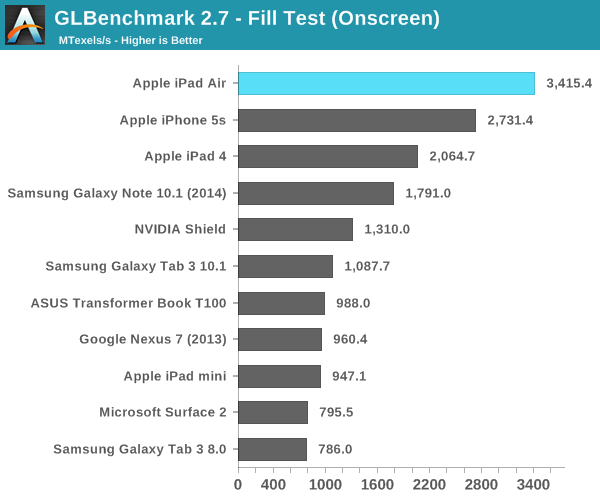
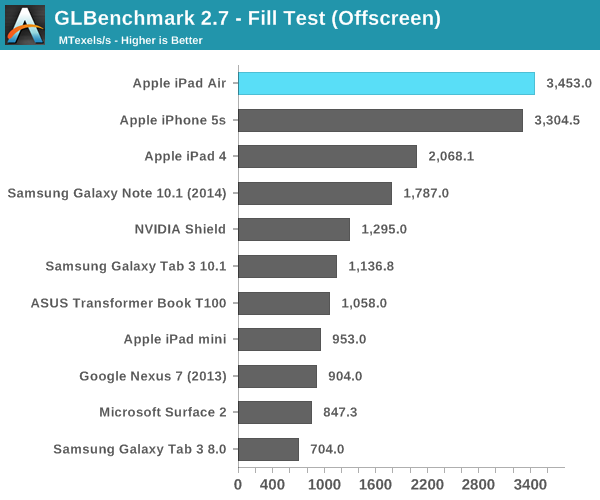
Looking at the fill rate results, there's a 4.5% increase in performance compared to the iPhone 5s. That could be the magnitude of clock increase that we're seeing between A7s. Apple could very well be relying on more thermal headroom in the iPad Air to provide any real world GPU performance advantages over the iPhone 5s.
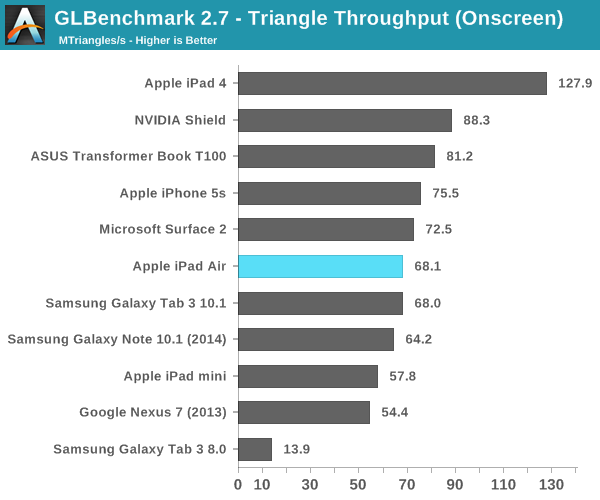

We see an even smaller gap between the Air and 5s in the triangle throughput tests (2.9%). There doesn't seem to be any substantial difference in GPU frequency between A7 implementations here. The regression in triangle rate performance compared to the iPad 4 is explained by differences in how Series 6 and Series 5XT GPUs scale in width. Whereas 5XT replicated nearly the entire GPU for "multi-core" versions, multi-cluster versions of Rogue only replicate at the shader array. The result? We don't see the same sort of peak triangle setup scaling we did back on multi-core 5XT parts. I'm not sure I'm particularly happy with the magnitude of the regression here, but I haven't seen any real world cases where it matters yet.
Next up are the game simulation tests. We'll start with the more strenuous of the two: T-Rex HD.
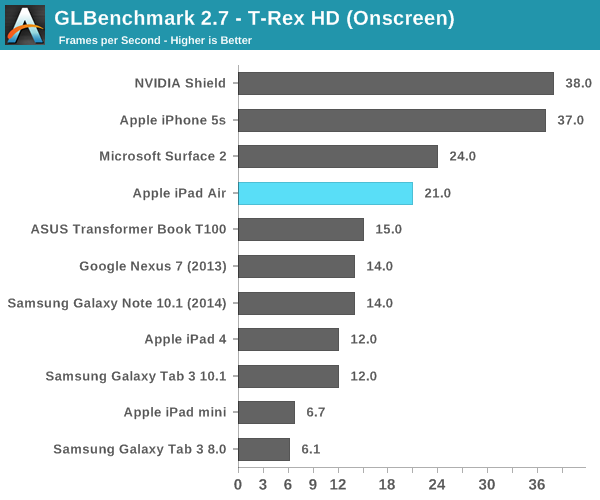
Here we get closer to Apple's claims of a 2x increase in performance. The iPad Air delivers 75% more performance than the iPad 4 in this test. Once again the iPhone 5s pulls ahead but that's because the onscreen tests render at display resolution, which is lower on the 5s.
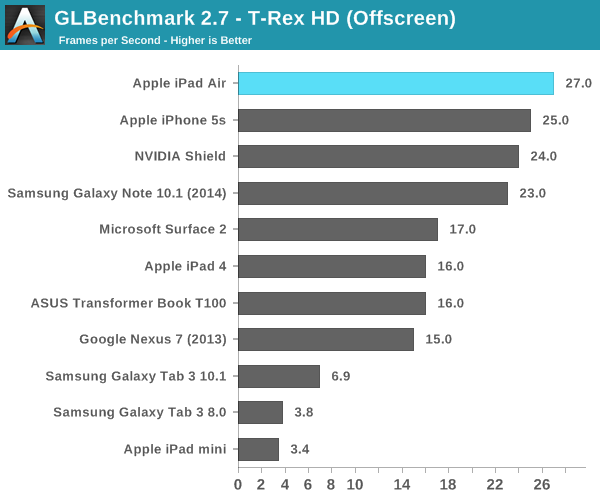
Offscreen performance sees similar scaling: ~69% better performance compared to the iPad 4.
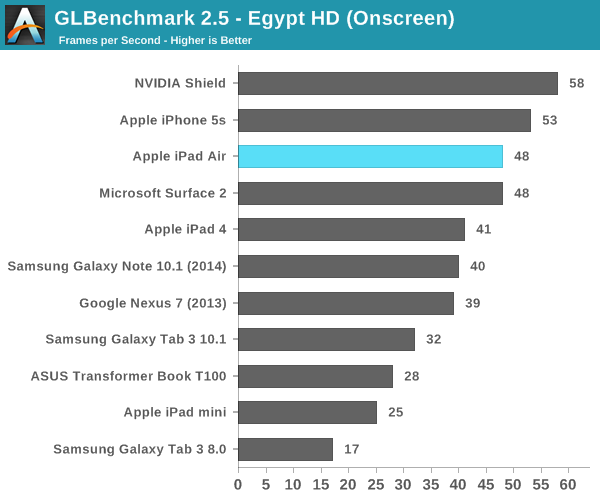
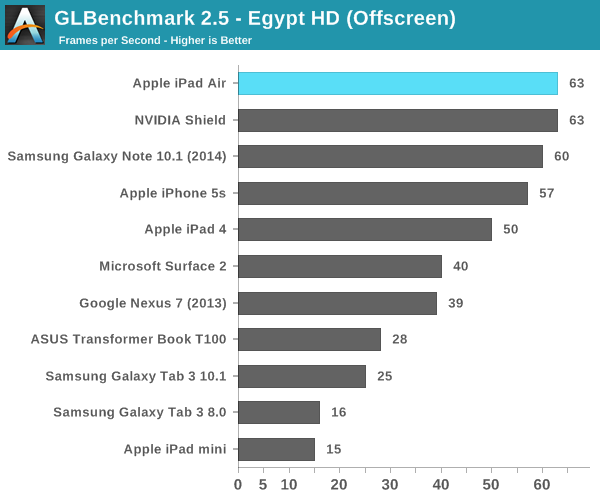
3DMark
We're once again running 3DMark's newest Unlimited mode which does its best to run independently of v-sync and at a standard resolution across all devices. I've also included 3DMark Extreme results below that feature a few more comparison points.
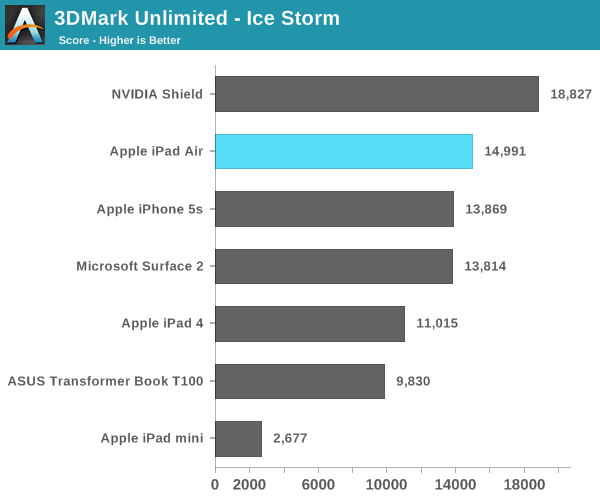
The overall Ice Storm scores show a 36% improvement in performance over the iPad 4 and an 8% increase compared to the iPhone 5s. Given the CPU frequency advantage of the A7 in the Air vs. the iPhone 5s, I'm guessing that's why we're seeing the performance gap we are here.
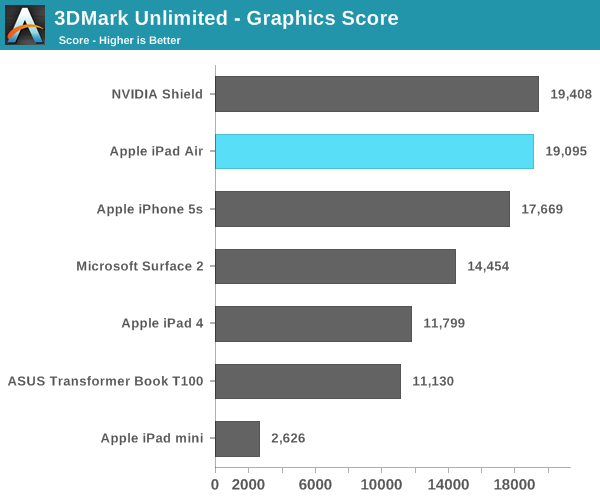
If we focus exclusively on the GPU tests (which themselves are still CPU bound), the iPad Air's performance advantage over the iPad 4 grows to over 60%.
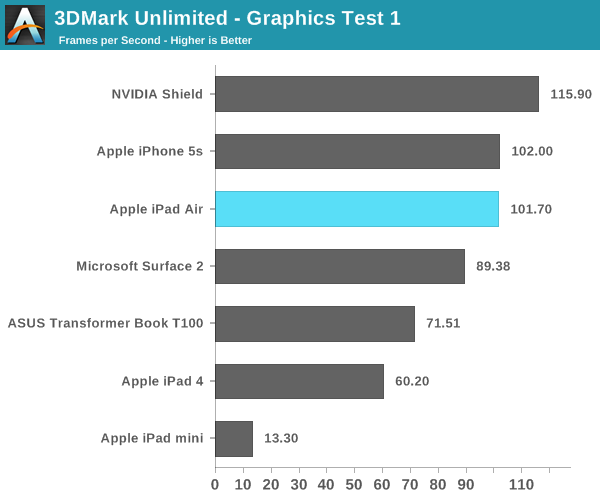
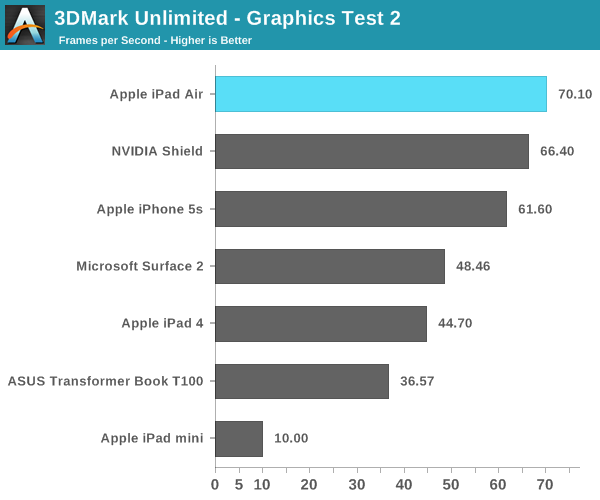
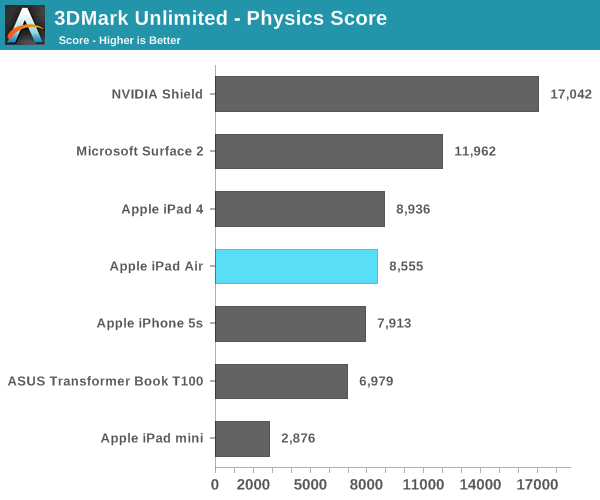
I'm still not entirely sure what's going on with the 3DMark Physics test, but we've seen this two reviews in a row now where Cyclone showed no performance increase at all compared to Swift despite this being largely a CPU test.
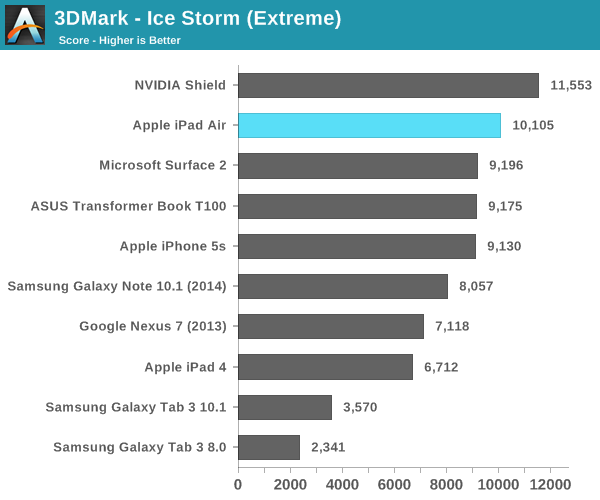
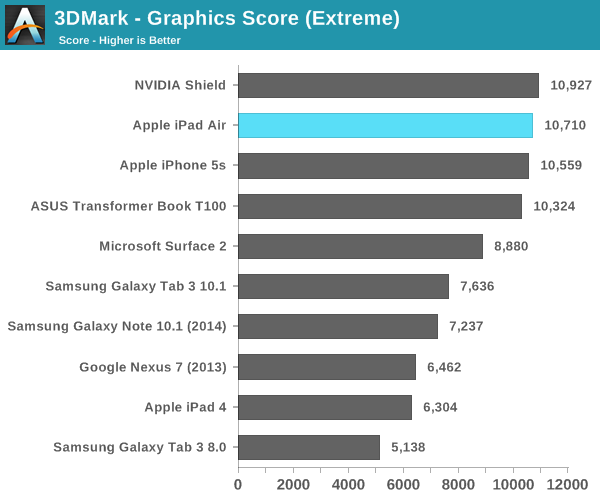
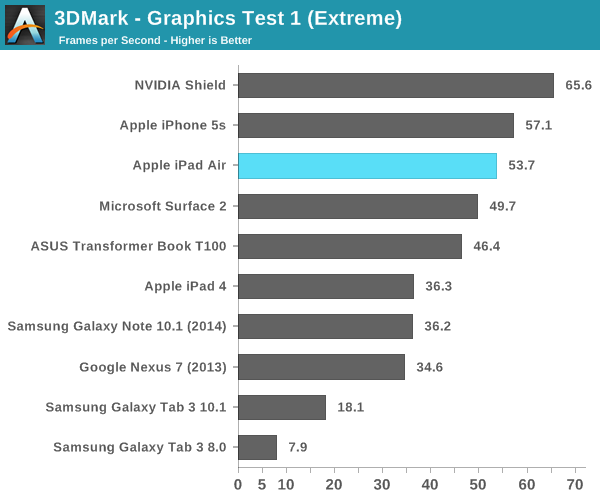
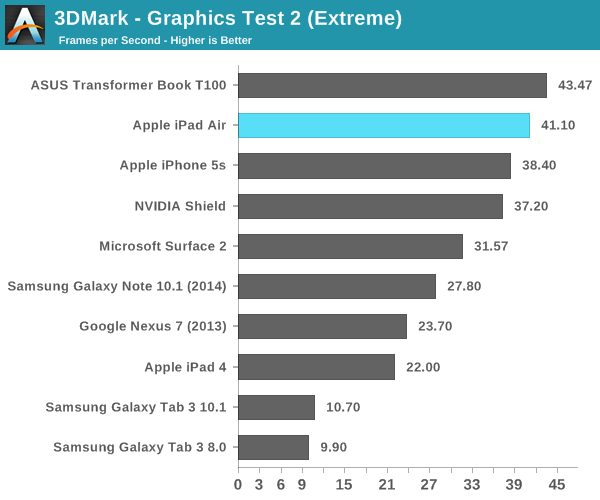

Basemark X
Basemark X is a new addition to our mobile GPU benchmark suite. There are no low level tests here, just some game simulation tests run at both onscreen (device resolution) and offscreen (1080p, no vsync) settings. The scene complexity is far closer to GLBenchmark 2.7 than the new 3DMark Ice Storm benchmark, so frame rates are pretty low.
I'm still having random issues with Basemark X reliably running both on and offscreen tests on iOS 7. Unfortunately I could only get onscreen results for the iPad Air, which came in at 46% faster than the iPad 4. Note the iPad mini and iPhone 5s benefit from having lower native resolutions here, which is why they perform so well.
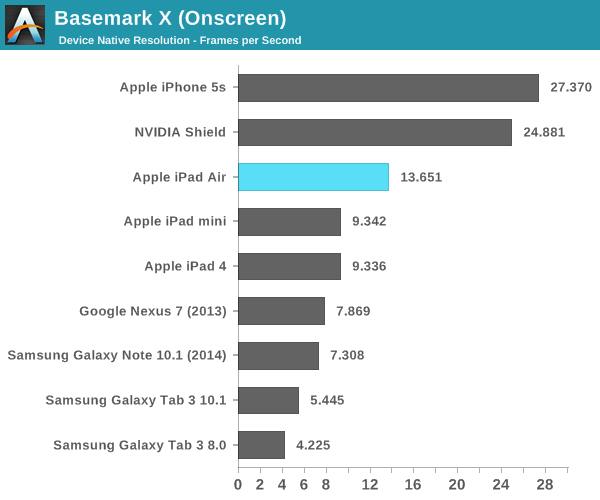










444 Comments
View All Comments
Wilco1 - Thursday, October 31, 2013 - link
The "cheats" do not prevent thermal throttling down at all - they simply switch to maximum frequency immediately. The issue is that many of the popular benchmarks run for such short periods (~10 milliseconds) that the DVFS has no time to switch to maximum frequency. A long running benchmark always runs at the maximum frequency.KoolAidMan1 - Wednesday, October 30, 2013 - link
CPU throttling for thermal reasons, one of the most common functions in CPUs and GPUs, is the exact opposite of an application boosting clock speed based on triggers from specific benchmarks and applications in order to game performance numbers.Blown away by the lack of thinking in the comments
KPOM - Wednesday, October 30, 2013 - link
Maybe because he had previously commented that Apple, Motorola, and Google don't cheat on benchmarks.Graag - Wednesday, October 30, 2013 - link
Look, lilo, we all know that you're an anti-Apple shill based on your posting history, so it's probably too much for you to actually understand what you're writing.The kind of cheating you are incorrectly remembering occurred when a device that *usually* throttled its frequency to save battery power did not throttle its frequency when it detected that a benchmark program was running.
Obviously, that's not what's going on here.
tential - Wednesday, October 30, 2013 - link
Dunno where all the hate is on this review.I read the Engadget review first, and was meh about it. I come here and I read a full hardware review. It's just amazing the amount of effort that goes into these reviews.
My only complaint is that anandtech doesn't review more products! Haha. I'd really like to see some ultrabook/lower end laptops reviewed. Some more routers as well. This is a great review though, I realy don't even want to waste my money now on a new tablet/phone when apple seems to have went full steam ahead to destroy competition in performance. it's too bad the average consumer knows nothing about this stuff though.
tential - Wednesday, October 30, 2013 - link
To further elaborate since people are saying this review favors Apple. The review of the Nexus 7 was also VERY NICE in terms of what google did. Anandtech is praising apple in this review, but they praise companies that do a good job period. I don't hitnk this review favors apple at all. It does point outa number of short comings as well.I think the Ipad Air is great, but Google NExus 7 definitely holds its own at the price point given and clearly there is an advantage for Apple with it's focus on its own ARM processor development because they develop their own processor for their own new OS while SnapDragon and Google work independently (to my knowledge at least).
Streamlined - Wednesday, October 30, 2013 - link
It's because the web is full of paid shills who post comments for money from Apples competitors.KoolAidMan1 - Thursday, October 31, 2013 - link
Its because tech forums are filled with paid shills from Apple's competitors and anti-Apple fanboys who will jump through as many mental hoops as possible to deny any positives their products and ecosystem hasprashy21 - Wednesday, October 30, 2013 - link
Anand,A very nice and detailed review ( as always ).
I have couple of points
"Touch ID" should have been part of it ( it's deal breaker for me to upgrade my 3rd gen iPad ).
As you pointed out 32GB should be norm now as Apple charges premium for their product.
azazel1024 - Wednesday, October 30, 2013 - link
Good overall review.However, I have to disagree a lot with the comment on speaker location.
Yes, you have trade-offs between both on top or bottom if held in portrait postion or one on top one on the bottom in portrait position. However, I do think Apple choose poorly with this. I can't believe I am the only one who pretty much watches movies 100% in landscape postion. On top of that probably 90% of my gaming is in landscape with the rare exception of a game that is only portrait (cut the rope for example). Probably more than 75% of my music listening is also in landscape (either because it is on a stand in landscape, or I am browsing the web in lanscape).
So for me personally, and I'd bet most other users, the times they'd be using the speakers, they are going to be using their iPad in landscape mode...which means they get no stereo.
The RF window could have been relocated to what is the side in portrait mode, or top when in landscape to accomodate repositioning of the speakers. Well, it should have anyway, though it might not be feasible with the internal layout of battery and boards.
One of those things that interests me in the T100 (other than, well, full windows) is proper placement of the speakers for stereo sound when I'd actually be using the speakers 90+% of the time (and better speakers it sounds like?).
Apple has kind of lost me through no real fault of their own though. The iPad was amazing when it first came out. The iPad 2 was great. The Retina iPad 3 had some big trade offs but an amazing screen (weight and charging time). The iPad 4 is...uh...an increment. The Air looks great and seems to be a huge improvement over the iPad 3/4.
The problem is that others have improved their game. Android has gotten much better as an OS over the intervening years and OEM/ODMs have really stepped up their game in Android tablet designs.
Windows 8 was an okay touch OS. 8.1 was a better (if not great, an okay) touch OS. Intel finally came out with a good enough (and in some ways, damned good) x86 Atom processor in Silvermont/Bay Trail.
iOS just doesn't have productivity potential in the areas I am interested in and zero compatibility with the productivity apps I use on the desktop/laptop (Lightroom being one of the main ones). For general content consumption, Android is cheaper with some rather good designs. Windows tablets, with the T100...are also cheaper and so much more productivity potential when needed.
I'll keep my iPhone, thank you very much. For a phone and phone OS, iPhones and iOS are great IMHO. For a tablet though, now that the hardware has continuously improved, I feel like it can finally deliver on productivity like I've always wanted it to. So an "appliance" operating system is no longer appropriate to me in a tablet (well, not a tablet I'd buy). The hardware is great, but the OS not so much anymore (for a tablet).